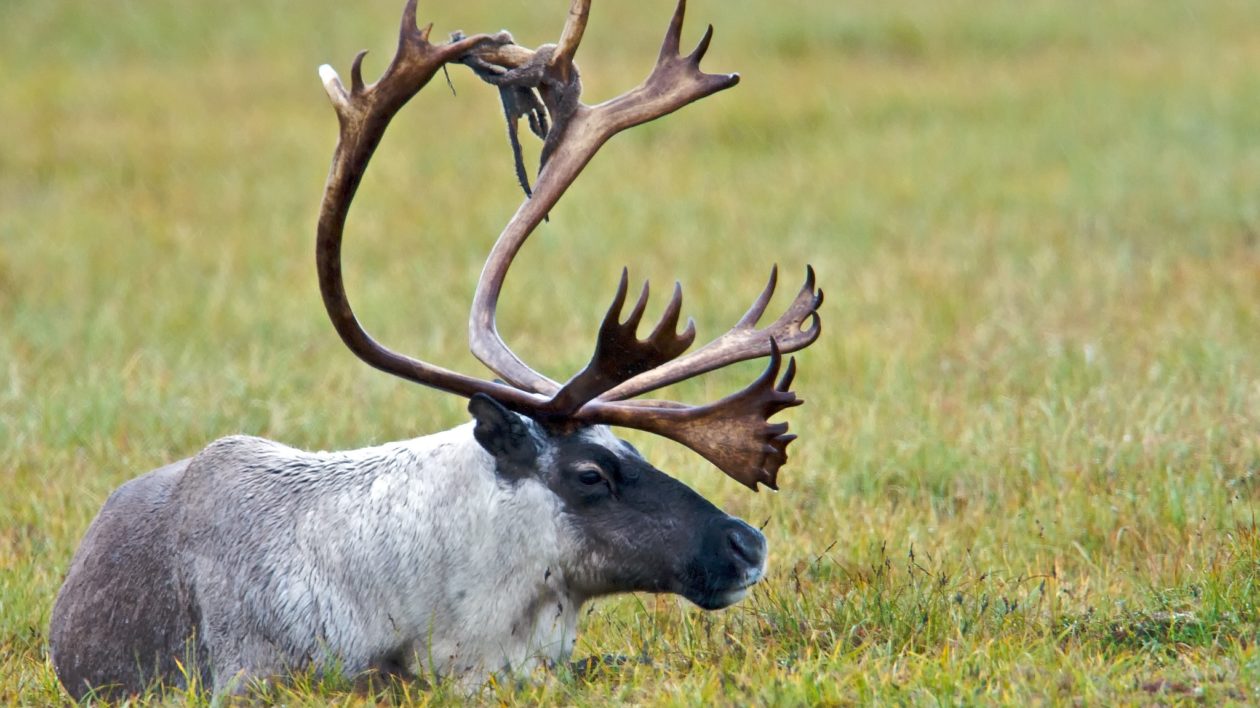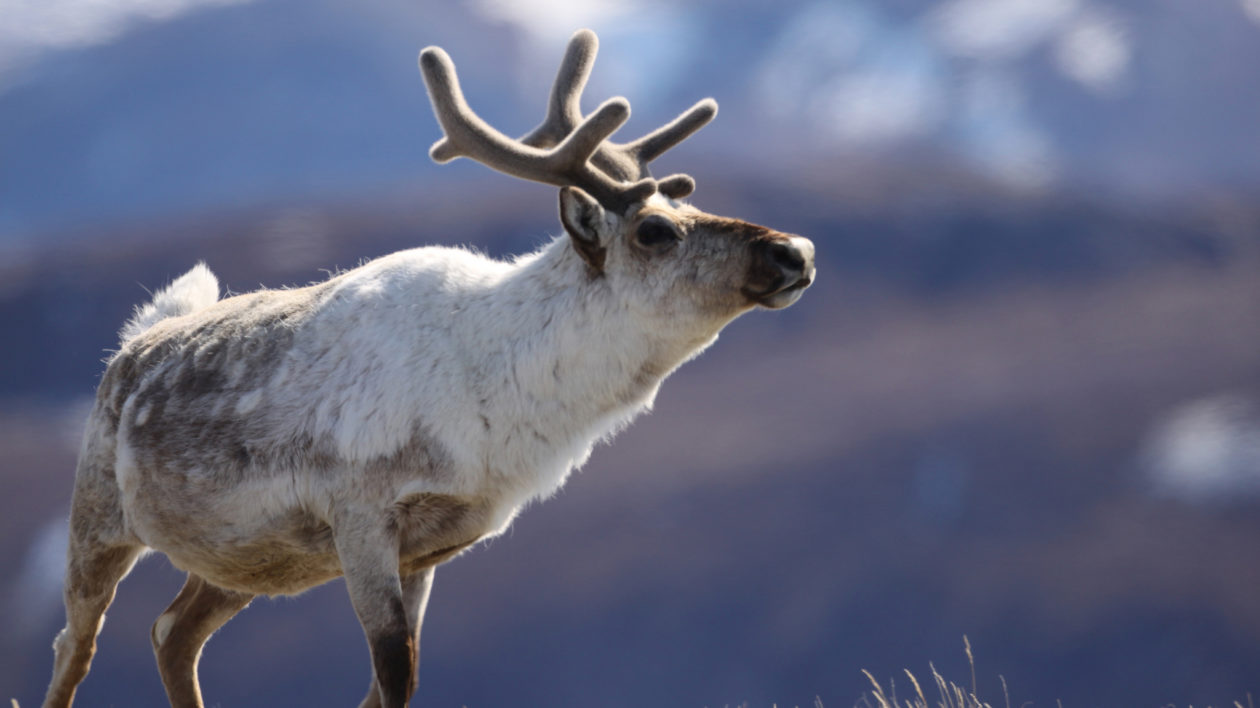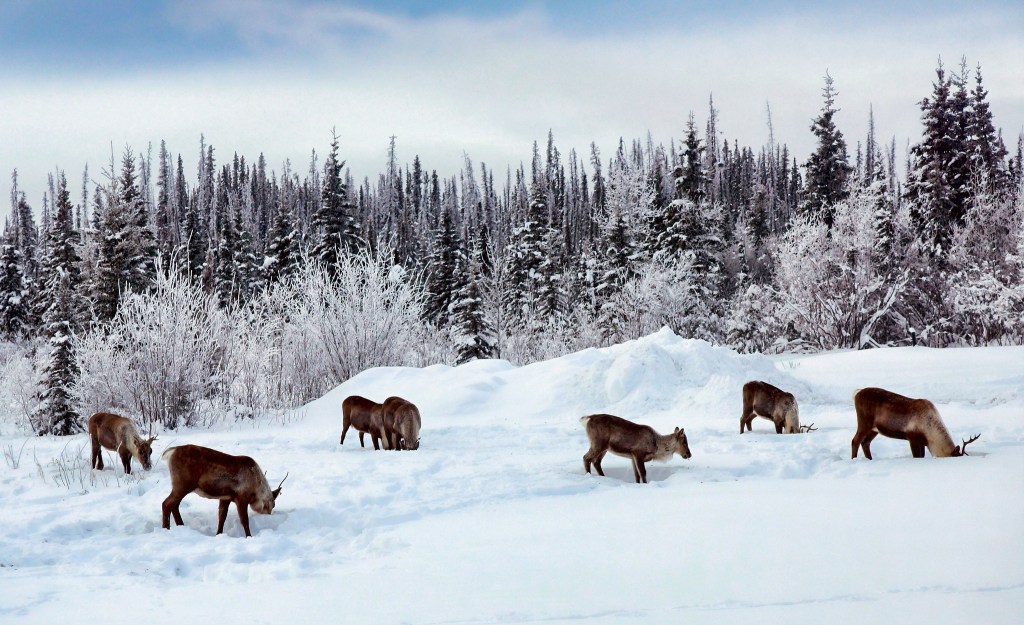From Rudolph to Frozen’s Sven, fictional reindeer are roaming just about everywhere I look. And while there’s no denying their holiday heroics, real reindeer are actually even more spectacular.
No, they can’t fly. And they don’t have red noses (but more on that in a bit).
But real reindeer have incredible habits and adaptations that allow them to thrive in harsh conditions.
Let’s look at some of the wonders of reindeer – including how they compare to their fictional counterparts.
First: What Is a Reindeer?
What is the difference between a caribou and a reindeer? They’re actually both the same species, Rangifer tarandus. Generally, caribou are what we call these animals in North America, where they roam wild in Canada and Alaska. Reindeer is the name given to the species in Europe and Asia.
There’s a further difference. Most reindeer in Eurasia are domestic, where they have been herded for at least 2,000 years. While these are the only fully domesticated deer, they often still roam widely and herders lead them on migration routes. However, domestic reindeer do have shorter legs and stockier builds than the wild versions.
Blogger Ronnie Drever breaks down the differences and provides more history in a previous Cool Green Science post.

Click, Click, Click
Up on the housetop, click, click, click…
If you had some reindeer prancing on your roof, you probably would hear a clicking sound. This is because reindeer have tendons that slide over foot bones as they walk, producing a loud click.
Many sources hypothesize that this click allows reindeer to hear each other in harsh or foggy weather, thus enabling herds to stick together.
Recent research has shown that the bigger the reindeer, the louder the click. A loud click may enforce social hierarchy or even help attract potential mates.
Antlers and Santa’s Reindeer
For most in North America, white-tailed and mule deer are the most familiar antlered animals. We know that bucks have antlers and does do not. This is also true for elk, moose and other members of the deer family. Except reindeer.
Both sexes of caribou and reindeer carry antlers. Many fictional depictions – like the ever-popular Rudolph television special – depict female reindeer without antlers, but that’s not the case. In fact, if the television show was based on reindeer biology, Clarice would be the one leading Santa’s sleigh.
Male reindeer drop their antlers after the breeding season, so most will be antlerless by Christmas day. However, female reindeer will usually keep their antlers until they have calves in the spring.
As such, the reindeer pulling Santa’s sleigh would most likely be females.

About that Nose
Reindeer noses are incredible, just not for the reason you think.
When you exhale in the cold air, you will see steam. Your breath is warmer than the air, of course. You will not see this for a reindeer. As reported by the BBC, the reindeer’s nose cavity actually cools air coming from the lungs by an astonishing 70 degrees Fahrenheit before it is expelled in the air. As such, water vapor is condensed before it enters the air.
And when a reindeer breathes in, the nose warms the air before it enters the lungs.
This helps the reindeer conserve heat and energy in the very cold conditions where it lives. Or, as the research paper on the topic puts it, “The heat and water recovered by the nasal temporal counter-current heat exchanger in reindeer significantly reduced the metabolic cost of survival during cold exposure.”
The reindeer’s nose is full of blood vessels. When viewed with thermal cameras, it appears – you guessed it – reddish. You could even say it glows.
This is just one of many adaptations that help reindeer thrive in cold, seemingly harsh environments. In fact, we imagine reindeer struggle to survive in Arctic conditions, but they actually do just fine. It’s warm weather, and the resulting mosquitoes and parasites, that can make life tough on reindeer. Which is why climate change poses serious challenges to these animals.

Real Reindeer Don’t Need the Glowing Nose, In Any Case
Robert May was a copywriter for the Montgomery Ward department store chain who was assigned to write a holiday story about an animal in 1939. As he stared out his Chicago window, as writers are known to do, he noticed thick fog, which got him wondering how Santa’s reindeer could navigate. Hence the story of Rudolph was born.
However, real reindeer don’t need a red nose to cut through the fog. They are one of the few mammals that can see ultraviolet light.
Reindeer must adapt to extreme variations in light conditions. In the summer, they may have 24 hours of daylight, but winter similarly means darkness all day long. And the reindeer’s eyes change. In the summer they appear golden and function like many other animals. But in the winter, their eyes are blue, allowing “significantly increased visual sensitivity.” According to research in the Proceedings of the Royal Society B, this allows reindeer to detect lichens even beneath snow, and may also help detect predators (wolves, not Bumbles) in low-light conditions.

Don’t Give Them Carrots…
My brother and I always used to leave out carrots for Santa’s reindeer, never considering that Donner and Blixen would likely receive millions of carrots over the course of the evening. Naturally, a team of researchers sought to quantify just how many carrots reindeer receive on Christmas eve.
As reported in the Independent, they found that there are 3,063 tons of carrots left for reindeer just in the United Kingdom.
There’s a problem, though. Reindeer don’t eat carrots. As the Phil Endsor is quoted in the article, “Carrots aren’t part of their natural diet and reindeer struggle to digest carrots because they don’t have any incisor teeth on their upper jaw.”
Reindeer much prefer the aforementioned lichens, admittedly not the easiest snack to procure.
But Watch Your Pet Hamster
Oddly, while carrots are not on the reindeer menu, there are lots of stories online of them eating lemmings. Lemmings are the infamously cyclical and abundant rodents of the Arctic, and apparently reindeer dine on them when they trample them.
While nearly all references carnivorous reindeer are anecdotal, this may not be as outlandish as it sounds. After all, when lemmings experience population booms, they offer a lot of easy protein. (However, they do not commit suicide). Many animals, even herbivorous ones, are opportunistic. There are well-documented instances of white-tailed deer eating bird nestlings and rodents, so it seems reasonable to assume a reindeer might occasionally munch a lemming.
In that case, Santa’s reindeer might be more likely to eat your small pet than the carrots you leave. You’ve been warned.

And Then There are the ‘Shrooms
Here’s a bit of Rudolph trivia: When Robert May submitted the first draft of his story to Montgomery Ward executives, they reviewed and promptly rejected it. In a story that will be horrifyingly familiar to anyone who has ever been subject to editing by committee, the execs believed that readers would think Rudolph was a drunk. At the time, a red nose was a common caricature of excessive drinkers.
Of course, they were wrong and no one thinks about Rudolph drinking and flying. However, reindeer consuming psychedelic mushrooms is quite another story.
In fact, reindeer are reported to seek out the hallucinogenic fly agaric mushroom. The exact effects this has on the reindeer is unclear. However, there have long been stories that reindeer herders sometimes drink reindeer urine to experience the hallucinogenic effects. Folklore author Andy Letcher set out to dispel this as a myth, but ended up finding firsthand accounts from reindeer herders that verify this story.
Some have taken this even farther, and suggested that the whole idea of “flying reindeer” originated with hallucinating herders. This seems a gigantic leap, so to speak. The reality is that reindeer have been a part of human legends for a long time, and there are ancient “reindeer stones” in Siberia and Mongolia that depict what appear to be flying reindeer, predating domestication.

A Note About Conservation
Reindeer are incredible creatures, but they are in trouble. They may be one of the animal most affected by climate change. New energy development and other habitat loss is taking a toll. Their migration routes, some of the longest among mammals, can be easily disrupted.
Wild reindeer and caribou have experienced at least 40 percent population decline in the last quarter-century. Five herds in the Alaska-Canada region have declined by 90 percent. Last year, the last caribou remaining in the “lower 48” of the United States was relocated to another herd in Canada. Even domestic reindeer face a grim future; just last week, USA Today reported that hundreds of thousands of Scandinavian reindeer face starvation due to changing climate conditions.
Reindeer illustrate just how important wild animals remain for us culturally. They are essential parts of holiday celebrations and important characters in our popular stories. They are our sports mascots, toys and art. But we stand at a crossroads: Will wild animals become merely symbolic – fictional and legendary creatures that exist only in our imaginations? Or can we create a future where real reindeer and other large beasts thrive?
The choices you make this holiday season matter. So let’s celebrate the wonderful weirdness of the reindeer, and also work to make sure they continue roaming the Arctic.




Thank you for this wonderful piece about Caribou and Reindeer. We must all work very hard to protect them and all animals from climate change. Thank you Mathew L. Miller.
What great fun facts! Rather than publish a story about Rudolph in a newspaper around Christmas time, this should be published! This reality is way more fun and enlightening than the story of Rudolph.
Another superbly-written article, this time about one of my all-time favorites! Reindeer were always on my childhood Christmas wish lists, and it wasn’t until 2015 that I finally got to host one on my farm. Technically, she belonged to the DNR, and there were strict regulations, inspections, etc., but all was worth it. Indeed, what an amazing creature!
One more fact about reindeer to add to the above: every single hair follicle is hollow in the middle, affording them not only better insulating qualities, but also the ability to float better when crossing waterways!
For my Grandson’s note to Santa, can you please tell me the biting force of reindeer? Time is of the essence, obviously, lol . Thank you!
After reading this article a new love was found as I never knew that reindeer really exist at age 37 so I thank you for this article that I am going to share with my children ages 9 and 14 which they probably are educated on this as to I was not.
Thank you for a fascinating and informative article!
Thank you for this delightful and informative article about reindeer. I can’t wait to share it with my grandchildren!
Love this article-Thanks Mr. Miller. I am a docent at a local zoo, we are always talking about animal adaptations in an effort to help people appreciate just how amazing animals are, but I find that unless we can present the information in a “fun fact” kind of way, like you have done with this article, we soon lose their interest. There are still lots of ‘myths’ out there.
Wonderful article – thank you!
It is quite amazing to read about this beautiful creature and learn about their many “weird” characteristics. May they thrive on this planet for a long long time.
Great read! Entertaining, yet informative, and thought-provoking. I can’t wait to share it.
Very good briefing on Reindeer. Hope that they will be protected against climate changes. Hope that UN will pay attention to prevent climate change, by reducing meetings and stepping into actions.
What a wonderful, informative and cautionary article. Thank you, Matthew. I always enjoy where you take us, although i don’t always take the time to write. The large animals and the winter animals are in such danger.
Thanks for reading and commenting. I am glad my stories resonate. Have a great holiday season. Matt
We were blessed to be the caretakers of an orphaned, imprinted caribou, and she was a delight! With the help of the DNR, we learned a lot about these fascinating creatures, but your fine article contained even more information than I knew! Thanks for a truly interesting and personally-meaningful read!
Matthew:
love your articles and publish them in our paper often.
But do I have permission to use the photographs that come with your articles. I notice they are copyrighted.
Ed M, editor New Messenger Christiansburg Va.
I’m glad you enjoy the articles. For photos, it really depends. For many, the photographers own the rights so they can’t be used without permission. You can email me a m_miller @ tnc . org for more information. Thanks again for your interest. Matt
Great article Matthew and I love that you did it. I learned a lot and plan to share it with my family. They are magnificent animals. The reduction in their herds and habitat is painful to read. We humans as a full unit do not seem to be able to grasp the scope of what lies ahead. Plus those in the developed world have to grasp it without the support and buy-in by “leaders” that are quickly moving onto how they can extract rare metals from the moon and make the next grand profit. ☹️